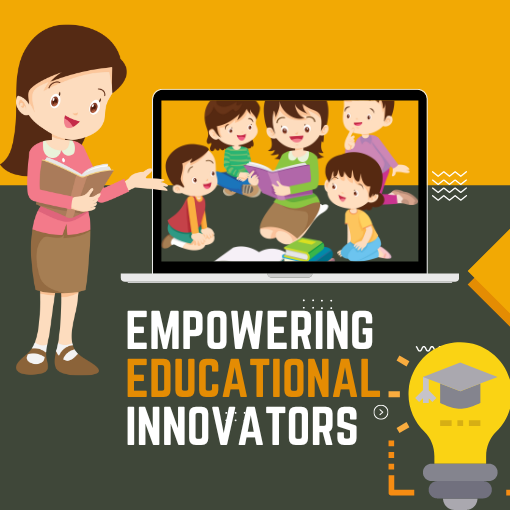Overview:
It is said that the seeds of invention are planted at an early age and that as technology progresses, learners of all ages are given the potential to become innovators. The primary objective is to encourage all students, instructors, and schoolteachers to participate as innovators in the educational process—people who can tackle social problems and have created new ways of thinking as well as skill sets.
The famous saying is :
Innovation is not about tools. It’s about people, processes, and pedagogy.
There are three things we should keep in mind while empowering educational innovators.
1. Innovation Design
2. Professional learning
3. Research and evaluation
Empowering educational innovators through the use of technology:
The use of technology by educators can provide them with the ability to access various materials, enabling them to deliver more targeted and, in some circumstances, individualized instruction to their pupils.
Technology should boost teacher-student engagement by improving access to information, data, and networks, allowing teachers to better support student learning.
Evidence from all over the world suggests that, as a result of efficient technology usage in education, teachers’ roles become increasingly important, rather than peripheral, over time. Technology will substitute some of what teachers do now while also assisting teachers in taking on new, often more advanced duties and obligations due to technological development.
Despite the significant number of research that has been done on how teaching and learning are affected by digital technologies, the findings have not yet reached a definitive conclusion.
Teachers can be learning facilitators, members of learning teams, collaborators with outside expert mentors, peer mentors to parents, and team leaders on project-based learning activities, among other things.
At the same time, in situations with a shortage of teachers or where educators are of a “low capacity,” technology can potentially assist students to partially overcome this deficit. It’s possible that this will occur when there is limited availability of teachers or when teachers are of a “low capacity.”
Technology can enable the use of organized lesson plans or content prompts to help increase instructors’ competence in areas lacking material or pedagogical skills.
“Teachers’ attitudes and beliefs about technology’s relevance to student learning had the most impact on their achievement.”
It is necessary to look further than the discussion over the influence of general technological use on education and open space for more incredible research regarding the types of technologies instructors are using, the reasons for which they are utilizing them, and how they are utilizing them.
The conclusion of a systematic study of the effect of technology on the educational attainment of students aged 5 to 18 states.
“There is no doubt that innovation engages and encourages young people”
However, for this benefit to be useful for learning, one must successfully match the activity in question with the content that is intended to be acquired.
Because of this, the pedagogy behind the deployment of technological devices in the classroom is what needs to be prioritized rather than the specifics of the technology itself.
It’s difficult to challenge teaching and learning beliefs. Digital technology in schools changes teaching and learning.
This is the most important takeaway that can be drawn from the research. Using technology in the classroom does not preclude using innovative pedagogical techniques.
For example :
For instance, a randomized study conducted in elementary schools led researchers to conclude that “virtual coaching allowed just one coach to complete the same work that three educators performed during the on-site coaching intervention.”

Therefore, virtual coaching has the potential to be a meaningful solution to the problem of locating a large number of high-quality teachers in education systems that perform poorly.
After observing 100 primary school teachers, it was determined that transforming teachers (adopting innovative technology-supported teaching methods) required extensive, active, and continual school and district leadership.
“Recent research claims that higher education needs revival and that this update may be accomplished by taking steps to empower innovators and students.”
Five groups outline teachers’ beliefs and attitudes:
They established a classification of teachers with diverse attitudes toward Information and communication technologies (ICTs) for learning.
- ICT enthusiasts,
- partial enthusiasts,
- information-focused instructors,
- partial doubters with hope
- and complete doubters who reject ICT (Information and communication technologies) in schools.
This study shows how to establish digital skills policies and methods for instructors. It also highlights that there isn’t any one-size-fits-all method to promote technology usage among educators. Challenging teaching and learning beliefs isn’t easy.
“Digital technology in classrooms necessitates substantial changes in teaching and learning.”
What is the primary role of innovators?
Innovators should propose novel ideas and propose solutions to problems.
Innovators should feel free to propose novel ideas and advocate for solutions supported by empirical data to ensure that postsecondary institutions provide a first-rate education to the current and future generations.
Innovators should not be afraid to suggest unique ideas and fight for solutions supported by empirical facts to ensure that postsecondary institutions offer a first-rate education to the present generation and the generations to come.
Empowering educational educators and innovators through a teachers’ quality improvement program.
Since there is an immediate need to enhance the professional capabilities of teachers.The curriculum is focused on empowering teachers to become motivating instructors and providing them with the skills necessary to carry out an effective instructional strategy. It also boosts teachers’ intrinsic motivation and pride in their job. According to the ministry of education, a qualified teacher must have personal, social, educational, and professional competencies.
Conclusion:
So, in the bottom line, I must say that the primary objective is to encourage all educational innovators, such as students, instructors, educators, and schoolteachers, to participate as innovators in the educational process. We can empower educational innovators through technology and teachers’ quality improvement programs. I want to add to the last point that innovators should propose novel ideas and solutions to problems and fight for solutions supported by empirical facts to ensure that postsecondary institutions offer a first-rate education to the present generation and the generations to come.


